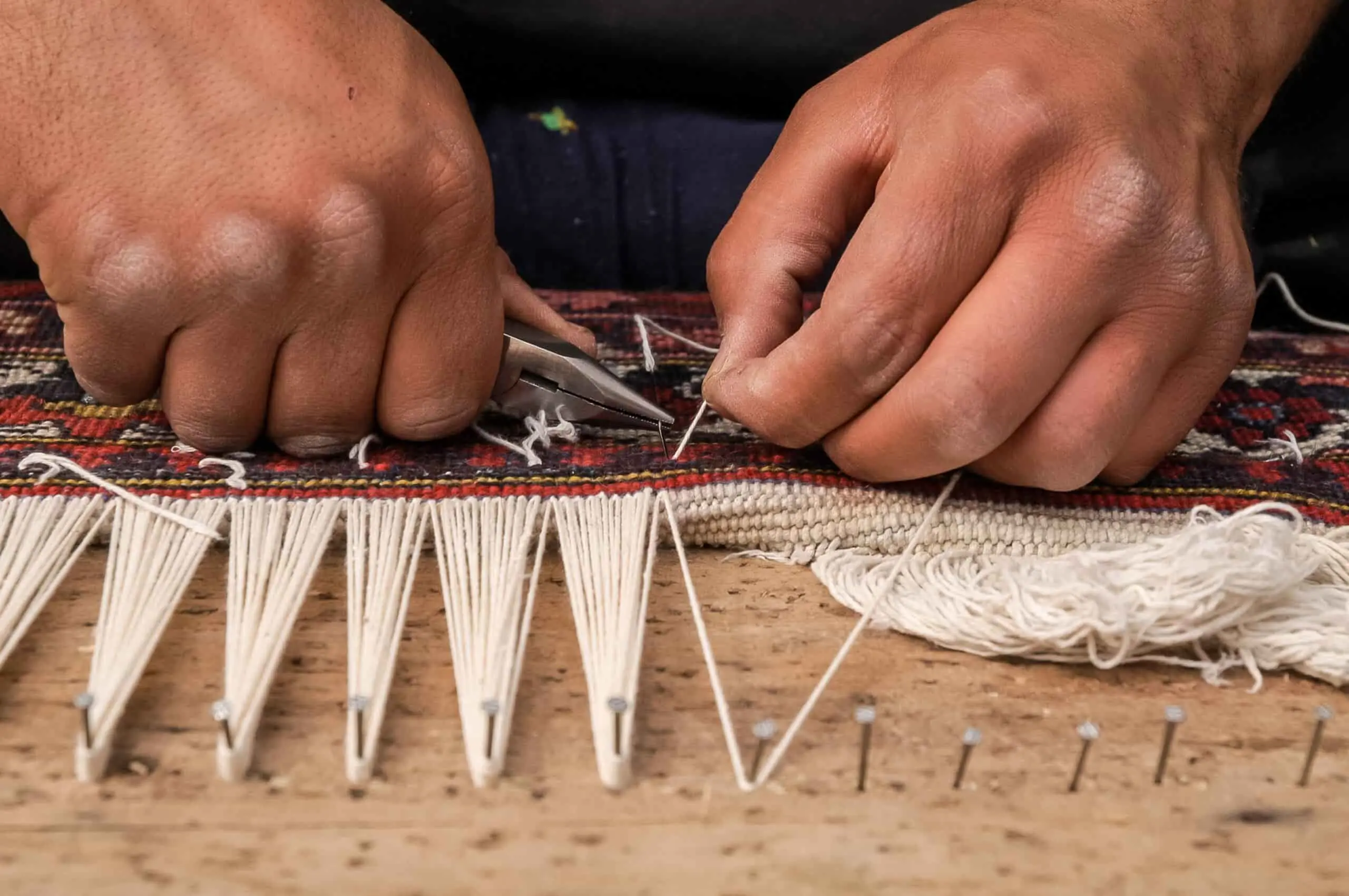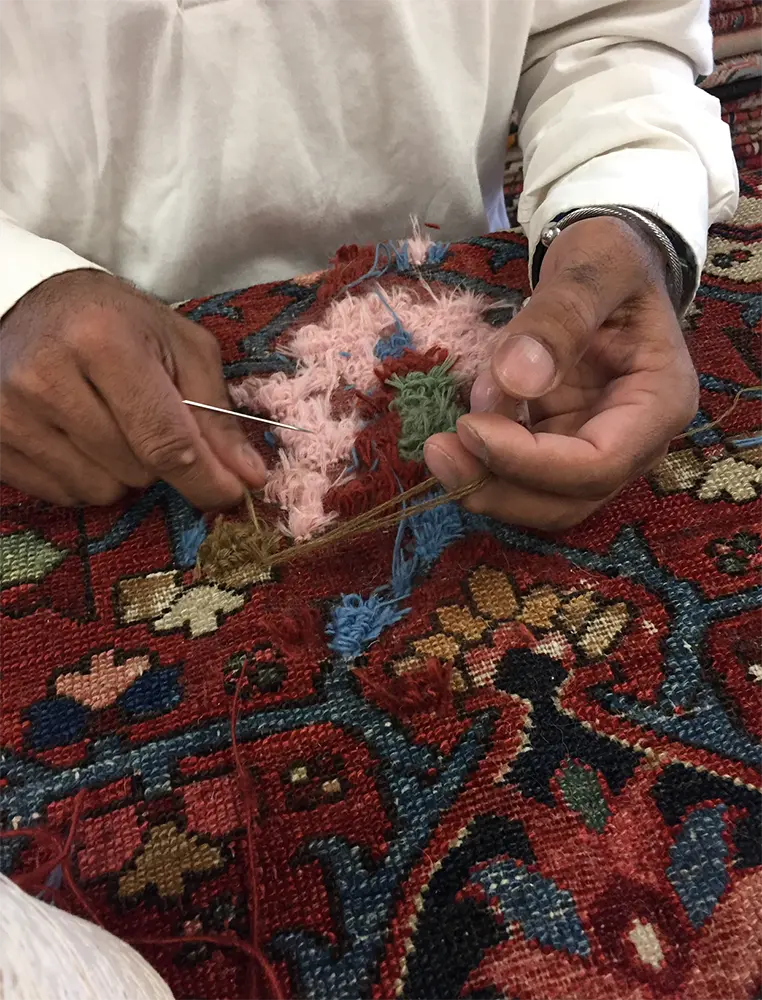A form of artistic expression honed over the ages, Persian rugs are more than just floor coverings. These magnificent pieces of art are prized not merely for their aesthetic appeal but also for their cultural importance. Numerous of these area rugs have symbolic meanings and are significant examples of Iranian heritage. Sadly, as time passes, these rugs may sustain damage that causes them to lose their original significance and worth. Here comes the role of Persian rug restoration. The aesthetic splendor of these rugs is preserved through restoration and guarantees that their cultural history is preserved for future generations.
This blog will discuss the importance of Persian rug restoration and how it helps to protect cultural heritage.
Persian Rug Restoration – Common Types of Damage and Wear in Persian Rugs: What to Look For
Persian rugs are known for their durability but are not immune to damage and wear. Over time, foot traffic, sunlight exposure, and even the occasional spill can take their toll on these exquisite works of art. It’s important to know what types of damage to look for so that you can take action before the damage becomes irreversible. In this article, we’ll cover some common types of damage and wear that can occur in Persian rugs, as well as tips on how to spot them.
- Wear and Tear: One of the most common types of damage in Persian rugs is wear and tear. This is caused by foot traffic over time and can manifest in several ways. Look for areas of the rug where the fibers are thinner, or the pile has been worn down, especially in high-traffic areas like doorways or hallways.
- Fading: Sunlight can cause colors to fade over time, and Persian rugs are no exception. If your large rug is in an area that receives direct sunlight, check for areas where the colors have lost their vibrancy or where there is a noticeable difference in color between exposed and unexposed areas.
- Stains: Spills and accidents happen; if not treated promptly, they can leave stains on your Persian rug. Look for areas where the colors have changed or where there are noticeable spots or discolorations.
- Moth Damage: Persian rugs are made from natural fibers, which can attract moths. Moth damage is characterized by small holes or areas of missing fibers, especially in areas of the rug that are less frequently trafficked.
- Curling or Fraying: The edges of a Persian rug can sometimes curl or fray over time, especially if the rug is not adequately secured to the floor or placed in a high-traffic area.
By watching for these types of damage, you can catch problems early and take action to prevent further damage. Regular cleaning and maintenance and professional Persian rug restoration when necessary can help ensure that your Persian rug remains a cherished piece of your home’s décor for years to come.
Persian Rug Restoration – The Benefits of Restoration: Preserving Value and Meaning for Future Generations
More than merely lovely floor coverings, Persian rugs have a rich history. These are pieces of art that have significance in both culture and history. Sadly, even the best-maintained Persian rug can suffer damage or deterioration over time, losing its original worth and significance. Here comes the role of Persian rug restoration. The aesthetic splendor of these rugs is preserved through restoration and guarantees that their cultural history is preserved for future generations. In this post, we’ll look at the advantages of Persian rug restoration and how it helps keep its worth and significance alive for upcoming generations.
- Value Restored: The value of an adequately restored Persian rug may even rise over time. This is especially valid for old or expensive rugs. The rug’s original beauty, artistry, and quality can be preserved during Persian rug restoration, making it a worthwhile investment.
- History and Culture Preserved: The history and culture of the area where Persian rugs were made are frequently reflected in them. We are preserving a piece of cultural legacy for upcoming generations to admire and learn from by recovering antique rugs.
- Improved Aesthetics: Repairing a Persian rug can restore its former splendor, boosting its aesthetics and transforming it into the center of attention in any space. A well-maintained rug can enhance other decorative accents, creating a harmonious and welcoming environment.
- Longer Lifespan: A Persian rug’s lifespan can be increased by restoration, enabling many more years of enjoyment. This is crucial for ancient rugs, which are frequently delicate and require extra care.
- Environmental Sustainability: We are decreasing trash and promoting environmental sustainability by recovering a Persian rug. A valuable work of art can be reused and repurposed through restoration instead of being discarded and replaced.
Persian Rug Restoration – The Role of Expertise in Restoration: Why Experience and Knowledge Matter
It is not a job that should be done lightly to restore a Persian rug. It necessitates a profound comprehension of these artistic creations’ materials, processes, and cultural legacy. Here is when knowledge is valuable. A trained and professional restorer can significantly improve the quality and longevity of a restored Persian rug. We will discuss the function of skill in Persian rug restoration in this post and the importance of experience and knowledge.
- Material Knowledge: Wool, silk, and cotton are natural materials used to make Persian rugs. A knowledgeable restorer is well-versed in these materials, including how they respond to various cleaning procedures, dyes, and environmental factors.
- Technical Mastery: Hand-sewing, knotting, and natural dyeing are just a few of the skills used in Persian rug repair. An expert restorer is familiar with these methods and knows how to use them on various rug kinds and types of damage.
- Persian rugs are more than just lovely fabrics in the context of their culture. They have a solid cultural and historical foundation in Iran. A knowledgeable restorer is aware of this situation and can preserve the cultural significance of the rug while restoring it.
- Detail-Orientation: Repairing a Persian rug requires a sharp eye for minute details. A talented restorer can spot minute differences in color, texture, and pattern to ensure that the repaired rug is as similar to the original as possible.
- Quality Guarantee: You may rest easy knowing that your Persian rug is in good hands if you hire a seasoned and competent restorer who can offer a quality guarantee for their work.
Knowledge is important for restoring Persian rugs. A trained and competent restorer can ensure that your rug is restored with attention to detail and respect for its cultural heritage, producing a superb Persian rug restoration that will last for years.
DIY Restoration: When to Attempt it and When to Call in the Professionals
Persian rug restoration can be a complex, drawn-out procedure that takes a lot of skill and knowledge. It may be tempting to try DIY restoration to save money, but it’s crucial to know when to do it yourself and when to hire a professional. The variables to consider when selecting whether to attempt DIY restoration or hire specialists will be covered in this article.
- Damage Kind and Extent: Your Persian rug’s damage type and extent will be a key factor in assessing whether DIY restoration is necessary. Minor stains or damage like frayed edges could be manageable with a do-it-yourself strategy. Still, more significant damage, like holes or sizable tears, might need professional assistance.
- Persian rugs are manufactured from various natural materials, and their restoration calls for various processes. It is better to leave the Persian rug restoration to the experts if they are unfamiliar with these materials or processes.
- Time and Skill: Restoration is a labor-intensive process that demands high skill and meticulousness. It is preferable to bring in the experts if you need more time or expertise to dedicate to the restoration process.
- Value and Emotional Attachment: While choosing whether to undertake DIY restoration, you should also consider your Persian rug’s worth and sentimental attachment. It is recommended to leave the repair to the experts if the rug has sentimental or financial significance to ensure it is kept and restored correctly.
- Cost: DIY repair may appear to be a cost-effective option, but if mistakes are made or the restoration needs to be done correctly, it may be more expensive in the long term. It is required to compare the costs of DIY restoration with those of professional restoration.
Even though DIY Persian rug restoration may be appropriate for minor damage, it is important to take into account the type and extent of the damage, the material and technique, the time and skill, the value and sentimental attachment, and the cost before deciding whether to try DIY restoration or hire professionals. By making an informed choice, you can ensure that your Persian rug is appropriately restored and conserved for years.
The Bottom Line
Suppose you have a Persian rug that requires restoration. In that case, it is important to choose a restoration service that is professional, qualified, and experienced in handling delicate and valuable rugs. At Shabahang Royal Carpet, we have a team of skilled and experienced restorers passionate about preserving Persian rugs’ beauty and cultural significance. Our Persian rug restoration services are tailored to meet the specific needs of each rug, ensuring that the restoration work is done to the highest standard. We use only high-quality materials and techniques and are committed to providing our clients with the best possible service. So if you are looking for a professional and reliable Persian rug restoration service, look no further than Shabahang Royal Carpet.




